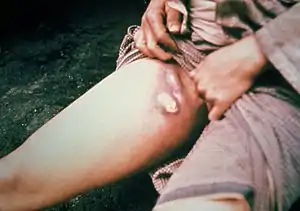Bubo
A bubo (Greek βουβών, boubṓn, 'groin') is adenitis or inflammation of the lymph nodes and is an example of reactive lymphadenopathy.[1]

Classification
Buboes are a symptom of bubonic plague and occur as painful swellings in the thighs, neck, groin or armpits.[2] They are caused by Yersinia pestis bacteria spreading from flea bites through the bloodstream to the lymph nodes, where the bacteria replicate, causing the nodes to swell.[3] Plague buboes may turn black and necrotic, rotting away the surrounding tissue, or they may rupture, discharging large amounts of pus.[3] Infection can spread from buboes around the body, resulting in other forms of the disease such as pneumonic plague.[4]
Management
Plague patients whose buboes swell to such a size that they burst tend to survive the disease.[3] Before the discovery of antibiotics, doctors often drained buboes with leeches or hot rods to save patients.[3][5]
Buboes are also symptoms of other diseases, such as chancroid and lymphogranuloma venereum.[6][7] In these conditions, a two-week course of antibiotics is the recommended treatment, and incision and drainage or excision of the swollen lymph nodes is best avoided.[8][9] However, aspiration may sometimes be performed to prevent buboes from rupturing.[9] Although incision and drainage yields better results in such cases—since usually no further intervention is necessary, whereas repeat aspirations may be required—incision and drainage wounds may heal more slowly, increasing the risk of secondary infection.[9]
References
- Drancourt, Michel; Piarroux, Renaud; Bitam, Idir; Mouffok, Nadjet; Raoult, Didier (2013-01-01). "Plague: History and contemporary analysis". Journal of Infection. 66 (1): 18–26. doi:10.1016/j.jinf.2012.09.010. ISSN 0163-4453. PMID 23041039.
- Paul, Slack (2012). Plague: a very short introduction. New York: Oxford University Press. p. 5. ISBN 9780199589548. OCLC 749871251.
- Orent, Wendy (2004). Plague : the mysterious past and terrifying future of the world's most dangerous disease. New York: Free Press. ISBN 978-0743236850. OCLC 54034997.
- Isberg, Ralph R.; Davis, Kimberly M. (2014-09-18). "Plague's Partners in Crime". Immunity. 41 (3): 347–349. doi:10.1016/j.immuni.2014.09.003. ISSN 1074-7613. PMID 25238090.
- Nesfield, V.B. (1911). "The treatment of bubonic plague by the immediate incision of the glands". The Lancet. 178 (4601): 1262–1264. doi:10.1016/S0140-6736(01)42126-X.
- Lewis, D. A. (2003-02-01). "Chancroid: clinical manifestations, diagnosis, and management". Sexually Transmitted Infections. 79 (1): 68–71. doi:10.1136/sti.79.1.68. ISSN 1368-4973. PMC 1744597. PMID 12576620.
- Morse, Stephen A.; Holmes, King K.; Moreland, Adele A.; Ballard, Ronald C. (2011). Atlas of sexually transmitted diseases and AIDS (4th ed.). Edinburgh: Saunders/Elsevier. ISBN 9780702047640. OCLC 761212082.
- "Guidelines for the Management of Sexually Transmitted Infections. February 2004: 2. TREATMENT OF STI-ASSOCIATED SYNDROMES: 2.2. Genital ulcer: Inguinal bubo" (PDF). apps.who.int. Retrieved 2019-02-13.
- Lewis, David A (2014). "Epidemiology, clinical features, diagnosis and treatment of Haemophilus ducreyi – a disappearing pathogen?". Expert Review of Anti-infective Therapy. 12 (6): 687–696. doi:10.1586/14787210.2014.892414. ISSN 1478-7210. PMID 24597521.